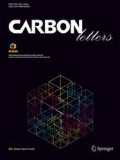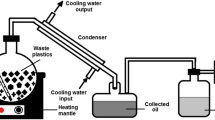Abstract
Pyrolysis fuel oil (PFO) is used for the manufacturing of high-purity pitch for carbon precursor due to its high carbon content, high aromaticity, and low heterogeneous element and impurity content. Pitch is commonly classified with its softening point, which is most considerable physical property affecting to various characteristics of the carbon materials based on pitch, such as electrical and thermal conductivity, mechanical strength, and pore property. Hence, the softening point should be controlled to apply pitch to produce various carbon materials for different applications. Previous studies introduce reforming process under high pressure and two step heat treatment for the synthesis of pitch with high softening point from PFO. These methods lead to a high process cost; therefore, it is necessary to develop a process to synthesize the pitch with high softening point by using energy effective process at a low temperature. In this study, waste polyethylene terephthalate (PET) was added to control the softening point of PFO-based pitch. The pitch synthesized by the heat treatment with the addition of PET showed the softening point higher than that of the pitch synthesized with only PFO. The softening point of PFO-based pitch synthesized at 420 °C was 138.3 °C, while that of the pitch synthesized by adding PET under the same process conditions was 342.8 °C. It is proposed that the effect of the PET addition on the increase in the softening point was due to the radicals generated from thermal degradation of PET. The radicals from PET react with the PFO molecules to promote the polymerization and finally increase the molecular weight and softening point of the pitch. In addition, activated carbon was prepared by using the pitch synthesized by adding PET, and the results showed that the specific surface area of the activated carbon increased by the addition of PET. It is expected that the pitch synthesis method with PET addition significantly contributes to the manufacture of pitch and activated carbon.





Similar content being viewed by others
References
Chen C-Y, Liang A-H, Huang C-L, Hsu T-H, Li Y-Y (2020) The pitch-based silicon-carbon composites fabricated by electrospraying technique as the anode material of lithium ion battery. J Alloys Compd 844:156025. https://doi.org/10.1016/j.jallcom.2020.156025
Kim B-H, Kim J-H, Kim J-G, Bae M-J, Im JS, Lee CW, Kim S (2016) Electrochemical and structural properties of lithium battery anode materials by using a molecular weight controlled pitch derived from petroleum residue. J Ind Eng Chem 41:1–9. https://doi.org/10.1016/j.jiec.2016.07.006
Jo YJ, Lee JD (2019) Effect of petroleum pitch coating on electrochemical performance of graphite as anode materials. Korean J Chem Eng 36:1724–1731. https://doi.org/10.1007/s11814-019-0354-3
Ko S, Choi J-E, Yim H, Miyawaki J, Yoon S-H, Jeon Y-P (2019) Improved understanding of the molecular structure of pyrolysis fuel oil: towards its utilization as a raw material for mesophase pitch synthesis. Carbon Lett 29:307–317. https://doi.org/10.1007/s42823-019-00027-x
Kim J, Im U-S, Lee B, Peck D-H, Yoon S-H, Jung D-H (2016) Pitch-based carbon fibers from coal tar or petroleum residue under the same processing condition. Carbon Lett 19:72–78. https://doi.org/10.5714/CL.2016.19.072
Han YJ, Hwang JU, Kim KS, Kim JH, Lee JD, Im JS (2019) Optimization of the preparation conditions for pitch based anode to enhance the electrochemical properties of LIBs. J Ind Eng Chem 73:241–247. https://doi.org/10.1016/j.jiec.2019.01.031
Kim B-H, Kim J-H, Kim J-G, Im JS, Lee CW, Kim S (2017) Controlling the electrochemical properties of an anode prepared from pitch-based soft carbon for Li-ion batteries. J Ind Eng Chem 45:99–104. https://doi.org/10.1016/j.jiec.2016.09.008
Kim JH, Kim JG, Lee KB, Im JS (2019) Effects of pressure-controlled reaction and blending of PFO and FCC-DO for mesophase pitch. Carbon Lett 29:203–212. https://doi.org/10.1007/s42823-019-00022-2
Thompson RC, Moore CJ, vom Saal FS, Swan SH (2009) Plastics, the environment and human health: current consensus and future trends. Philos Trans R Soc Lond B Biol Sci 364:2153–2166. https://doi.org/10.1098/rstb.2009.0053
Turnbull L, Liggat JJ, MacDonald WA (2013) Thermal degradation chemistry of poly(ethylene naphthalate)—a study by thermal volatilisation analysis. Polym Degrad Stab 98:2244–2258. https://doi.org/10.1016/j.polymdegradstab.2013.08.018
Levchik SV, Weil ED (2004) A review on thermal decomposition and combustion of thermoplastic polyesters. Polym Adv Technol 15:691–700. https://doi.org/10.1002/pat.526
Ko K-H, Sahajwalla V, Rawal A (2014) Specific molecular structure changes and radical evolution during biomass–polyethylene terephthalate co-pyrolysis detected by 13C and 1H solid-state NMR. Bioresour Technol 170:248–255. https://doi.org/10.1016/j.biortech.2014.06.109
Seo SW, Choi YJ, Kim JH, Cho JH, Lee Y-S, Im JS (2019) Micropore-structured activated carbon prepared by waste PET/petroleum-based pitch. Carbon Lett 29:385–392. https://doi.org/10.1007/s42823-019-00028-w
Kim JG, Kim JH, Song B-J, Lee CW, Im JS (2016) Synthesis and its characterization of pitch from pyrolyzed fuel oil (PFO). J Ind Eng Chem 36:293–297. https://doi.org/10.1016/j.jiec.2016.02.014
Kim JG, Kim JH, Song B-J, Jeon YP, Lee CW, Lee Y-S, Im JS (2016) Characterization of pitch derived from pyrolyzed fuel oil using TLC-FID and MALDI-TOF. Fuel 167:25–30. https://doi.org/10.1016/j.fuel.2015.11.050
Yu R, Liu D, Lou B, Chen Q, Zhang Y, Li Z (2018) Influence of boiling point range of feedstock on properties of derived mesophase pitch. AIP Conf Proc 1971:050017. https://doi.org/10.1063/1.5041208
Kim JH, Choi YJ, Im JS, Jo A, Lee KB, Bai BC (2020) Study of activation mechanism for dual model pore structured carbon based on effects of molecular weight of petroleum pitch. J Ind Eng Chem 88:251–259. https://doi.org/10.1016/j.jiec.2020.04.022
Ryu SK, Kim SY, Li ZJ, Jaroniec M (1999) Characterization of silver-containing pitch-based activated carbon fibers. J Colloid Interface Sci 220:157–162. https://doi.org/10.1006/jcis.1999.6523
Xing Z, Qi Y, Tian Z, Xu J, Yuan Y, Bommier C, Lu J, Tong W, Jiang D-e, Ji X (2017) Identify the removable substructure in carbon activation. Chem Mater 29:7288–7295. https://doi.org/10.1021/acs.chemmater.7b01937
Marshall I, Todd A (1953) The thermal degradation of polyethylene terephthalate. Trans Faraday Soc 49:67–78. https://doi.org/10.1039/TF9534900067
Jung J-Y, Park M-S, Kim MI, Lee Y-S (2014) Novel reforming of pyrolized fuel oil by electron beam radiation for pitch production. Carbon Lett 15:262–267. https://doi.org/10.5714/CL.2014.15.4.262
Acknowledgements
This work was supported by the Korea Institute of Energy Technology Evaluation and Planning(KETEP) and the Ministry of Trade, Industry and Energy(MOTIE) of the Republic of Korea (No. 20181110200070).
Author information
Authors and Affiliations
Corresponding author
Additional information
Publisher's Note
Springer Nature remains neutral with regard to jurisdictional claims in published maps and institutional affiliations.
Supplementary Information
Below is the link to the electronic supplementary material.
Rights and permissions
About this article
Cite this article
Kwak, C.H., Seo, S.W., Kim, M.I. et al. Waste plastic for increasing softening point of pitch and specific surface area of activated carbon based on the petroleum residue. Carbon Lett. 31, 991–1000 (2021). https://doi.org/10.1007/s42823-020-00211-4
Received:
Revised:
Accepted:
Published:
Issue Date:
DOI: https://doi.org/10.1007/s42823-020-00211-4




